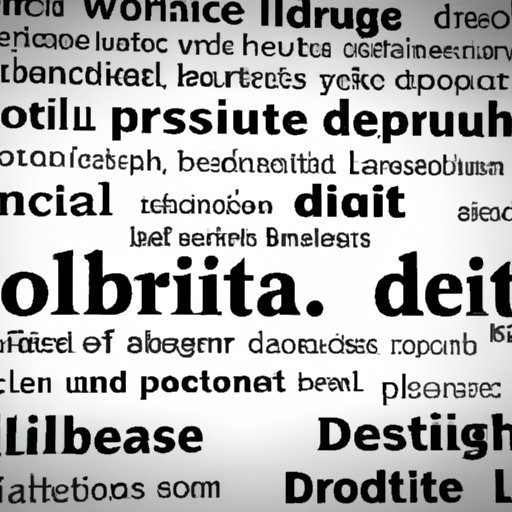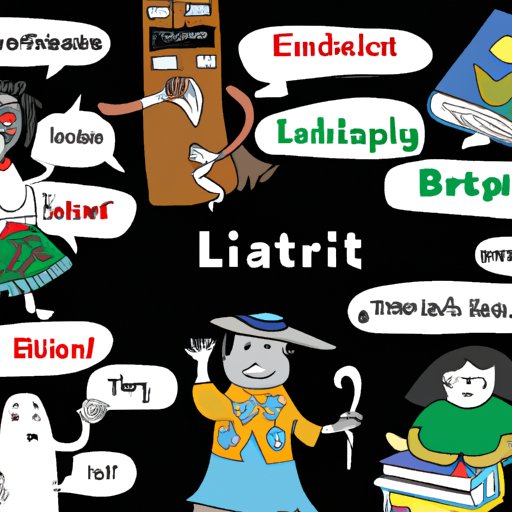Introduction
Dialect is an essential part of the English language and has been used for centuries to convey meaning and emotion. It is defined as “a distinct form of a language that is peculiar to a specific region or social group” (Oxford Dictionary). In literature, dialect can be used to create a sense of place, enhance characterization, and establish a tone and mood. This article will explore the different types of dialects used in literature and their impact on storytelling.
Exploring the Different Types of Dialects in Literature
Dialects are divided into three main categories: regional, social, and historical. Regional dialects refer to varieties of a language spoken in specific geographic areas, such as the American South or Scotland. Social dialects refer to differences in language based on social class, gender, ethnicity, or age. Historical dialects refer to changes in language over time, such as Old English or Middle English.
An Introduction to Dialect in Literary Context
The purpose of dialect in literature is to give readers an insight into the characters and settings of a story. Dialect can add interest and depth to a story by creating a sense of authenticity and realism. According to literary scholar Robert Scholes, “dialect is a powerful means of conveying a character’s background, personality traits, emotions, and relationships with other characters” (Scholes, 1983).

How Dialect Enhances the Storytelling Experience
Dialect can be used to create a sense of place and to enhance characterization. By using dialect, authors can evoke a particular setting and give readers a sense of what it would be like to live there. For example, Mark Twain’s use of Southern dialect in The Adventures of Huckleberry Finn creates an authentic and vivid picture of life in the Mississippi River Valley. Similarly, dialect can be used to reveal a character’s background, personality traits, and emotions.
Dialect can also be used to establish a tone and mood. Authors can use dialect to emphasize certain words or phrases and to create a more immediate and intimate connection between the reader and the characters. The use of dialect can also add humor to a story, as seen in the works of writers such as Ernest Hemingway and James Joyce.

Understanding the Role of Dialect in Character Development
Dialect is an important tool for developing characters in literature. By using dialect, authors can show a character’s background, personality traits, and emotions. For example, in Harper Lee’s To Kill a Mockingbird, Atticus Finch speaks in a formal, educated dialect to contrast with the rural Southern dialect of his neighbors. This helps to illustrate the difference between Atticus and his surrounding community.
Authors can also use dialect to reveal a character’s emotions. By using dialect, authors can emphasize words or phrases to create a more immediate and intimate connection between the reader and the characters. For example, in William Faulkner’s As I Lay Dying, the characters’ speech reflects their emotional states, from grief to anger to despair.

Examining the Power of Dialect in World Literature
Dialect has been used in literature for centuries, and its influence can be seen in works from all over the world. Examples of dialect from major works of literature include the Scottish dialect of Robert Burns’s Tam o’ Shanter, the Irish dialect of James Joyce’s Dubliners, and the African-American dialect of Toni Morrison’s Beloved.
The use of dialect in literature has a powerful impact on culture. By using dialect, authors can evoke a sense of place and provide an insight into different cultures and lifestyles. Dialect can also have a profound effect on readers, allowing them to connect with characters and gain a deeper understanding of the story.
Conclusion
Dialect is an essential part of the English language and has been used for centuries to convey meaning and emotion in literature. Dialect can be used to create a sense of place, enhance characterization, and establish a tone and mood. It is also an important tool for developing characters and revealing their backgrounds, personalities, and emotions. Finally, dialect has a powerful impact on culture and readers, allowing them to connect with characters and gain a deeper understanding of the story.
In conclusion, dialect is an integral part of literature and has an immense power to engage and captivate readers. By understanding the different types of dialects and how they can be used to enhance storytelling, authors can create works of literature that are both meaningful and memorable.
(Note: Is this article not meeting your expectations? Do you have knowledge or insights to share? Unlock new opportunities and expand your reach by joining our authors team. Click Registration to join us and share your expertise with our readers.)
